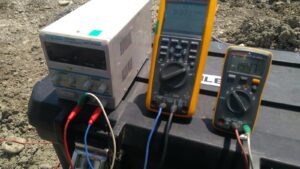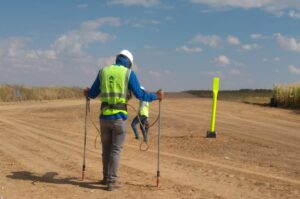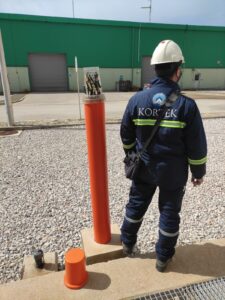Site Survey
Our team with NACE certified engineers and technicians specializes in cathodic protection site survey and inspection works.
What we offer?
- Cathodic protection transformer rectifier adjustment, inspection and basic troubleshooting
- Structure to electrolyte potential measurements to confirm CP criteria and check electrical isolation, continuity, shielding, stray current, coating evaluation, railroad crossing, road crossing etc.
- Direct current measurements to evaluate CP current direction and magnitude, pipeline longitudinal resistances, anode groundbed efficiency, continuity bond current, interference bond current and various other measurements.
- Diagnostic testing to test for deficiencies in CP system and identify possible causes of the problems to determine the requirements to enhance the CP system.
- Adjustive survey to ensure that the CP system meets the criteria, if not, adjust the system to achieve CP criteria. If the criteria cannot be achieved within the capacity of the system then diagnostic testing may be required to enhance.
- Commissioning survey is to confirm the new CP system can meet the design specifications.
- Close Interval Potential Survey (CIPS) is to outline process that will show clear picture of representative series of potentials throughout the structure (a pipeline) to evaluate the criteria for CP, to identify local deficiencies, to assist in identifying possible causes of such deficiencies and aid in determining the requirements to enhance the level of cathodic protection to the structure.
- DC stray current interference survey is to investigate the possibility of DC stray current on underground or submerged structures. There could be complex dynamic interference problems each should deeply be inspected and taken into account.
- Electrical isolation survey is to determine the effectiveness of aboveground or underground structures insulation features to check the electrical continuity between structures. So that the CP system could be inspected individually for each structure.
- Road and railroad cased crossing surveys to identify the insulation between the structure (usually a pipeline) and casing. So that the interference between two structures could be determined.
- Purpose of the soil resistivity measurement is to assess the corrosiveness of the soil. Soil resistivity values identify general environmental conditions that effects corrosion on buried metallic structures. These data have an import role as CP design parameter to assess appropriate protection along the structure.
- Direct Current Voltage Gradient (DCVG) survey is to determine the coating defects on the structure. DC source is produced along the structure and the current is interrupted. Current leakages occur on where the coating damage presents. Those current leakages produce voltage gradient as the DCVG surveyor walks towards them. The advantage of this survey is the possible location and the size of the defect could be estimated.



